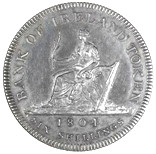

1916 Patrick Pearse (36), Tom Clarke (59) and Thomas MacDonagh (38) executed.Īugustine Birrell, Chief Secretary for Ireland since 1907, resigned.
OLD IRISH COINAGE SERIES
1968 The ‘May ’68’ civil unrest in France began with a series of student protests against capitalism, consumerism, American imperialism and conservative values.1469 Machiavelli, Renaissance writer, playwright and poet, author notably of The Prince (1513), born in Florence.


Went, Irish coins and medals (Dublin, 1978). Seaby, Coins and tokens of Ireland (London, 1970). John Stocks Powell is the retired librarian of York Minster Library and has written about the Portarlington area over many years. The female winged harp continued on British coinage until 1927, when a more Celtic design was substituted.
OLD IRISH COINAGE FREE
7, Publio Morbiducci design, 1927), when the Irish Free State established its first coinage in 1928 the cláirseach image was chosen in deliberate contrast (Fig. Harp symbolism became as important and iconic as other symbols of nationalism, and cláirseach harps, early harps, were utilised to challenge the crowned figured harp of the United Kingdom. Who reads the words on coins? Many counterfeiters, for amusement and avoidance, used different wording to escape any charge of deliberate imitation, such as Hispaniola, Britain’s Isles, North Wales and the delightful Music charms.Ī separate treasury and coinage survived the Act of Union into the 1820s, and in 1823 the last Irish coinage before independence carried the ubiquitous winged harp under a crown. Being base metal, penalties for counterfeiting were rarely capital. Profit lay with reduced weight and ease of distribution. 6).ĭuring the long eighteenth century, Irish coinage was limited to copper halfpence and farthings showing a crowned winged harp surrounded by the word Hibernia. Hibernia never plucked her harp but always rested her arm across the neck, as in Wood’s halfpence and farthings, 1722–4, notorious to Jonathan Swift (Fig. Catalogues describe the player as the Old Testament King David, but could the figure be Brian Boru? Hibernia first appeared in 1691 on the Limerick emergency money, after James II had departed for France and left the Irish to fight on alone (Fig. The only coin harp plucked came with the scarce Dublin tokens issued in the 1670s (Fig.

The harp became ornamented too, firstly with a bird’s head and then with an often bare-breasted female figure with wings that feature as the harp neck. James I’s harps in 1603 were turned round, with the soundboard on the right side, which has been the coin side ever since he also integrated the Irish harp into the royal coat of arms on British coinage, where it has since remained. The crowned Celtic harp continued through the sixteenth into the early seventeenth century. 2, 1555 shilling), while on the 1601/2 shilling of the ‘virgin queen’, Elizabeth, the harp sits in splendid isolation (Fig. It was the same with Mary and Philip (Fig. 1536) and K for Katherine Howard on the other. Sometimes the harp came between Henry and three of his wives, placing the crowned initials of H on one side and A for Anne Boleyn, I for Jane Seymour (Fig. The symbol was distinctive enough to separate the Irish coinage from passing into English currency. It is supposed that Pope Leo X gave a harp or cláirseach to Henry VIII at the same period as Fidei Defensor during that honeyed pre-Reformation period. Published in 18th–19th - Century History, 20th-century / Contemporary History, Artefacts, Early Modern History (1500–1700), Issue 3 May/June2013, Volume 21


 0 kommentar(er)
0 kommentar(er)
